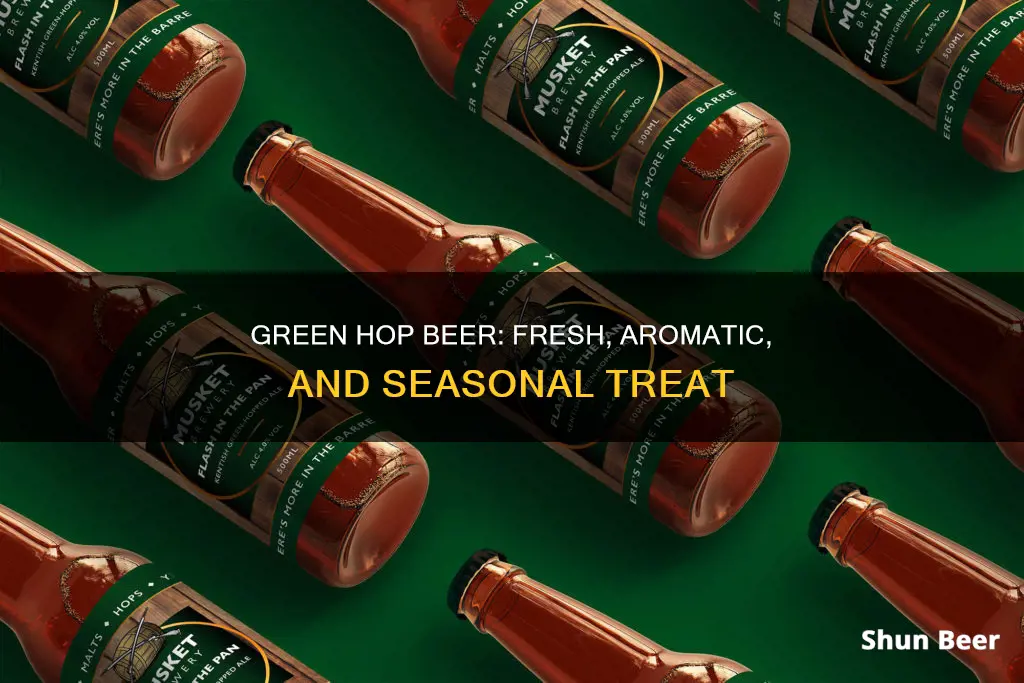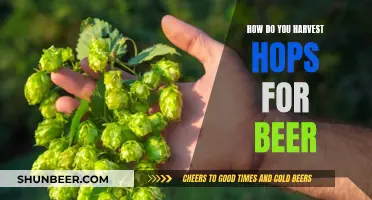
Green hop beer is a unique seasonal beer that can only be brewed during the hop harvest, which usually takes place in early September. Unlike traditional brewing methods, green hop beer is made with fresh hops that have been picked and used within 12 to 48 hours, as opposed to dried hops which can be stored and used throughout the year. The hops are added directly to the brew kettle, creating a distinct flavour and aroma. The process is a delicate one, with brewers having to act fast to get the hops into their beers as quickly as possible. The result is a beer with a fresh, green or hedgerow taste, with citrus and berry notes.
| Characteristics | Values |
|---|---|
| Hops | Fresh, or green, Kentish hops |
| Hop Usage | Must be used within 12 hours of being picked |
| Brewing Location | Must be brewed in Kent |
| Hop Source | Can only contain Kent-grown hops |
| Flavouring | Can only be flavoured with fresh, undried hops |
| Brewing Time | Must be brewed quickly, within 24-48 hours of hop harvesting |
| Hop Amount | Requires 4-8 times the amount of hops compared to dried hops |
| Flavour | Fresh, green, citrus, berry, woody, and herbal notes |
What You'll Learn

Kent Green Hop Beer
The secret to the distinct character of Kent Green Hop Beer lies in the use of fresh, green hops. Within 12 hours of being picked, these hops are added to the brewing process, imparting a truly singular flavour and aroma. The result is a beer that is best served fresh, capturing the essence of the season's harvest.
The annual hop harvest in Kent typically occurs from mid-August to early September, marking the beginning of the Green Hop Beer season. This brief window offers beer enthusiasts the opportunity to savour the unique taste of beers crafted from just-harvested hops. To commemorate this special time of year, Kent hosts a series of festivals and events that showcase the talents of its finest brewers.
One of the highlights of the Kent Green Hop Beer calendar is the Kent Green Hop Beer Fortnight, which takes place from late September to early October. This festival provides visitors with the chance to explore and taste Green Hop Beers from over 30 of Kent's esteemed breweries. The festivities kick off with the Canterbury Food and Drink Festival, where beer lovers can indulge in a variety of green hop beers alongside culinary delights from around the world.
In addition to the main festival, Kent's Green Hop Beer celebrations extend throughout the county. Events are held in pubs, breweries, towns, and attractions, inviting locals and visitors alike to embrace the heritage, industry, community, and creativity that define the region. From the historic hop farms of Scotney Castle to the vibrant Broadstairs Food and Drink Festival, there is something for everyone to enjoy.
Cascade Hops Beers: A Comprehensive Guide to Delicious Brews
You may want to see also

Green hops vs dried hops
Green hop beer is made with fresh hops, which are hops that are used within 12 hours of being picked. This is in contrast to the more traditional method of using hops that have been dried. The hops used in green hop beer contain many of the oils that are normally lost when hops are dried, giving the beer a characteristic fresh taste.
Green hops are hops that are used fresh, within 12 hours of being picked, whereas dried hops are hops that have been dried after picking and can be stored and used later. Dried hops comprise the majority of hop production in America, and most beers are made with dried hops.
Green hops are often called "wet hops" because they haven't been dried. A wet hops cone has about 80% water by weight, compared to only 8-10% for dried hops. This means that when brewing with wet hops, you need to use six to eight times as much hops as you normally would. Wet hops are also highly prone to moulding and oxidation, so they should be used within 24-36 hours of picking if possible.
Dried hops, on the other hand, are sealed and stored for later use. They are dried to a moisture level of about 8-10%, and then shaped into small pellets, which remain usable for up to three years.
Using green hops can give a beer a fresh, hoppy finish, and they are particularly well-suited to IPAs or traditional English ales. Brewing with green hops can only happen during the harvest season, and it creates a beer with a unique flavour and aroma.
Apple Cider Beer: Hops or No Hops?
You may want to see also

Green hops and moulding
Green hops, also known as "wet hops", are hops that are used in beer brewing without being dried first. They are highly susceptible to moulding and oxidation, so brewers typically need to use them within 24 to 48 hours of picking. The hops in this form contain about 80% water by weight, compared to only 8-10% for dried hops, so brewers need to use a lot more green hops than they would dried hops.
Because of the high water content and short shelf life, green hops are usually added during the boil, whirlpool, or dry-hopping phases of brewing, but not for both brewing and dry hopping. They impart vegetal, grassy, or tobacco flavours to the beer, which can be problematic for some styles but can also give a fresh hoppy finish if balanced properly. They work well in IPAs, where they accentuate the hoppy finish, and in traditional English ales, where they complement the complexity of the beer.
The hops plant is a vigorous, climbing, herbaceous perennial, and only female plants are used for commercial production. Hops are usually dried in an oast house before being used in brewing, but undried or "wet" hops have sometimes been used since the 1990s. Hops are added to the wort (sugar-rich liquid produced from malt) and boiled before it is cooled and yeast is added to start fermentation.
The first documented use of hops in beer was in the 9th century, although Hildegard of Bingen in the 12th century is often cited as the earliest documented source. Before this period, brewers used a gruit made from various bitter herbs and flowers. Hops were first cultivated in 736 in the Hallertau region of present-day Germany, and the first mention of their use in brewing in that country was in 1079. Hops began to threaten the use of gruit for flavouring in the 13th century, and hopped beer was first imported to Britain from Holland around 1400.
The Art of Describing Beer Hops
You may want to see also

Green hops in Kent
Kent is famous for its hops, and hops make beer. So, it's no surprise that Kent is also famous for its beer.
Every year, in the middle of August to early September, it's hop-picking time in Kent. This means that for a very limited period, there are fresh green hops available to brewers across the county. And that means we get to enjoy Kent's famous green hop beer.
Kent Green Hop Beer is made with fresh, or green, Kentish hops – instead of using hops that have been dried, as is more traditional in brewing. The hops used contain many of the oils that are normally lost when hops are dried, giving the beer a characteristic fresh taste. To ensure this fresh taste, the hops are used within 12 hours of being picked.
The annual Kent Green Hop Beer Fortnight, which runs from late September to early October, is a chance to taste newly released beers made from just-harvested hops produced by over 30 of Kent's finest brewers. The festival launches at the Canterbury Food and Drink Festival, which takes place in the Dane John Gardens in the heart of the city. The free event features local food and drink suppliers, with a marquee dedicated to Kent’s brewers and their green hop beers.
The following weekend, the festivities move to Broadstairs for the Broadstairs Food and Drink Festival. With over 100 stalls, a chefs' theatre and activities for kids, this festival has something for the whole family. Once again, local breweries will be providing opportunities to sample both their green hop and regular brews, alongside Kent’s flourishing cideries and distilleries.
Hoppy Beer, Happy Life: The Ultimate Guide to Hopping
You may want to see also

Green hops and the brewing process
Green hops are hops that are used fresh, without being dried first. They are also referred to as "wet hops" and are often picked and used within 12 to 48 hours. They are highly prone to moulding and oxidation, so brewers must be flexible with their schedules to ensure the hops are used at peak ripeness.
When brewing with green hops, the high water content of the hops must be taken into account. Brewers must use four to eight times as many green hops as they would dried hops. Green hops also lack a data sheet with an alpha percentage, so brewers must use an approximate value for the hops they are using. Green hops can be used during the boil, whirlpool, and dry-hop phases, but it is difficult to use them for both brewing and dry hopping due to their short shelf life.
Green hops are best used in beers like IPAs, where the fresh green flavours might accentuate the hoppy finish, or in traditional English ales where the complexity of the beer complements the wet-hops flavours.
The use of green hops in brewing can only happen during the harvest season, creating a beer with a unique flavour and aroma.
Grapefruit Beer: Hops-Infused Refreshment or Not?
You may want to see also
Frequently asked questions
Green hop beer is beer made with fresh, or green, hops. Instead of using hops that have been dried, green hop beer uses hops that have been freshly picked and contain many of the oils that are lost when hops are dried.
Green hop beer is made by taking hops directly off the bine and putting them straight into the beer. The hops are picked during the harvesting season and added directly to the brew kettles.
Green hop beer needs to be made within 24 to 48 hours of the hops being harvested. Ideally, the hops are put into the beer within 12 hours of being picked.
Green hop beer has a very different flavour and aroma compared to beer made with dried hops. It often has a fresh, green or hedgerow taste with citrus and berry notes or woody and herbal notes.
Green hop beer is made in Kent, in the South of England.







